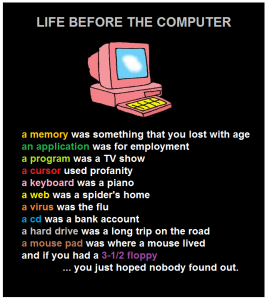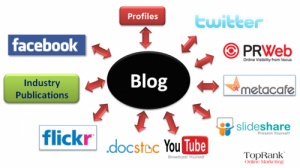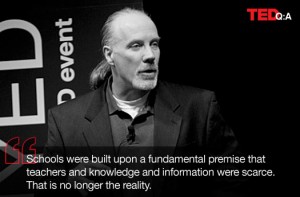Create your own mind maps at MindMeister
Week 1 Summative: “21st Century Thinking” is Different, We Need to Change Our Compass in Education
Reflecting on this week’s explorations, many aspects of the Connected Self and its disconnect in current educational practice have concerned me. In “Why School?” Will Richardson articulated the need for “different” education, not simply “better.” This stood out to me because I have witnessed a myriad of Ministry or administrative mandates regarding “integrating technology” in the classroom that all seemed like add-ons or poorly applied band-aids.
For example, in my school next year Grade 8 students, who once had an IT course, will now have a handful of sessions in the computer lab learning word processing and Power Point. Their “lessons” will be one period in the computer lab, separate and isolated from “the curricular” learning they were experiencing in Humanities 8 or Math and Science 8. The philosophy is that then students know how to use the tools and can utilize these skills in their future classes when the need arises. To me, this is a prominent example of the disconnection within the education system of the cognitive, cultural and technological dimensions of the connected self. For me, I believe that the cognitive dimension of the connected self is so disconnected within our schooling system that we are not unlearning and learning as our knowledge era reality requires. In TeachThought’s “How 21st Century Thinking is Different,” it is clear that “in an era of brazen technology,” in such new contexts as “digital environments that function as humanity-in-your-pocket—demand new approaches and new habits. Specifically, new habits of mind.” Currently, our education system is not adequately addressing these “new habits of mind,” and instead seems to launch into practices without the cognitive dimension as a guiding compass.
Furthermore, at the precipice of week one’s conclusion I find that the need for a concerted effort to integrate “The New Literacies” in the use of and through technology is very important to me. We opened class with a discussion of social media in education, and this is an area I would like to investigate as the course progresses. I think that many of the emerging literacies are involved in social media, and I would like to collaborate to explore how social media can be utilized to broaden perspectives, deepen understanding, develop a more unified cognitive, cultural and technological connected self within the classroom.
10 Minutes of Fame: Blogger
“If we teach today as we taught yesterday, we rob our children of tomorrow”
– John Dewy
“Shape of the Day” for my 10 Minutes of Fame on Blogger
- Opening class survey: Who utilizes a classroom blog now? Why? Is a virtual classroom necessary for our practice as teachers and Teacher-Librarians? Why or why not?
- 3-4 minutes: Individually explore any of the following links to my current classroom blogs. Please explore what interests you-layout, links, posts, student comments, videos, etc. While exploring please consider 1.) What are the advantages of blogger? 2.) What are the disadvantages of Blogger? 3.) What changes would you recommend?
- My Virtual Classroom, a.k.a home base
- English 12 Class Blog
- Socials 10 Class Blog
- Humanities Co-op Class Blog
- Family Heritage Webquest & Debate Topics Webquest
- Class Sharing: “Do Schools Kill Creativity?”, Technology and Us, Text and Opinion, Work Experience Reflections, Water Crises Reflections, Book Review
- 5-6 minutes: Large group share. I would also like to share how and why I use Blogger in my classroom, and more importantly, after using it in all classes this year, learning what I don’t like and what changes and practices I envision.
Why I use Blogger in the classroom:
- Promotes transparency, for as Richardson advocates: “Getting into a transparent, digital sharing practice [. . .] extends our teaching far beyond our classrooms” (2012, “Why School?”)
- Student’s ownership and choice in their learning. A proficient edublogger, Tran Nguyen also states that blogs in learning are “highly motivating to students, especially those who otherwise might not become participants in classrooms.”
- a central hub for information, sharing, and connecting as a class, as well as an essential archive of learning. Edublog Insights illuminates that “the archive feature of blogging records ongoing learning. It facilitates reflection and evaluation.” Students can easily find their thoughts, as well as connected resources and ideas, to see how their thinking has changed and why.
How I use Blogger:
- Share materials, news, downloads, links for students’ ownership of their learning: “It’s not what I know, it’s what we know” (2012, Richardson)
- Provide adaptation materials, enrichment and inquiry opportunities. Just as the BC Education Plan has articulated that there are “supports needed to use technology to empower the learning” (2012)
- Communicate with parents, tutors, and absent students
- Facilitate online discussions and collaboration. This is essential, as outlined in the Ministry’s Digital Literacy Competencies: Students need collaborative experiences in digital environments to develop individual learning, collective knowledge and to facilitate the learning of others.
- Critical thinking, personal responses and reflections
- Ongoing skill development in communication, social learning and multiliteracies. For example, “Community Corrections.” See Top 10 Most Unforgivable Spelling Mistakes on Twitter.
- Formative assessment, descriptive feedback, and peer-feedback
- As a space inherently connected with the learning and experiences shared in class, and the portfolio course design utilized throughout.
Hopes for Improvement:
- More consistent system for student contributions to the class blog
- Establish a system of quality peer review/feedback for students’ contributions
- Showcase more of the students’ learning experiences throughout, such as photographs of in-class work, as well as more student creations/projects (with permission)
- Create distinct pages of multimedia resources for the various units or major themes of each course
- Youtube Channel connection. See my colleague’s Youtube channel as a sample
- Reduce unnecessary links. De-clutter.
Blogging Resources For You:
Educational Uses of Blogs Slideshare Presentation
The Benefits of Blogs in Primary Classrooms
Blogging in the Middle School Classrooms Slideshare Presentation
The Goal is to start here…………………………………..but avoid ending up here:
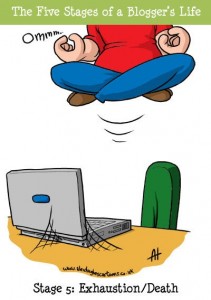
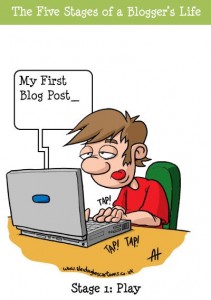
Information Literacy Won’t be Contained by a Definition’s Borders
According to the ALA information literacy is a set of abilities requiring individuals to “recognize when information is needed and have the ability to locate, evaluate, and use effectively the needed information” (2013). This is a simple, summative definition, which are education system’s prescribed learning outcomes are burdened with. Although such definitions offer a starting point. They ignore the complexity, flexibility, and multiplicity of such concepts as information literacy. Naturally, being able to “locate” information, which in today’s world is primarily digital, requires the numerous competencies associated with digital literacy. Further, to “evaluate” information requires the deep-processing skills of critical and media literacy. In addition, “to use” information can and should be in a multitude of modes, therefore requiring social literacy, visual literacy and more. The reading of our world is far from as simple as the definitions indicate.
Points of Inquiry, a guide produced by BCTLA does not attempt to concretely define information literacy, but rather, provides a framework for developing the skills. These include: connect and wonder, investigate, construct, express, reflect, and repeat continuously. I think that this is a more appropriate framework than the all-encompassing definitions ALA and the B.C. Ministry of Education attempt. Furthermore, Donald Leu of Syracuse University expresses it better than I ever could:
“The new literacies include the skills, strategies, and insights necessary to successfully exploit the rapidly changing information and communication technologies that continuously emerge in our world. A more precise definition of the new literacies may never be possible to achieve since their most important characteristic is that they regularly change; as new technologies for information and communication continually appear, new literacies emerge (Bruce, 1997; Leu, in press a; Reinking, 1998). Moreover, these changes often take place faster than we are able to completely evaluate them. Regular change is a defining characteristic of the new literacies.”
This seemingly simple observation has profound consequences for literacy and education. It means that we must help students learn how to learn, just as Richardson advocated (2012), in all literacies, and emerging literacies. However, today’s class exploration of varying mandates and draft curriculum, such as the Digital Literacy Standards, illuminate that there is little clarity. B.C. Performance Standards expresses the need for social responsibility to be taught, but it is unclear how this aligns with the digital literacy mandate, or even with specific courses. Unfortunately, as such, when these vital competencies are unclear cognitively and communicatively, they will be unclear in the classroom. The glimmer of hope is that educators are incredibly resilient and resourceful, turning to social media (such as Twitter and Pearltrees), and to each other, to develop the Professional Learning Networks that assist our teaching to the moving targets that are information literacy(ies).
“Why School?” and Our Ever-Changing Connected Self
School has always been a place that prepares children for the world, for their world, which they will inherit and co-create. Will Richardson, in “Why School?”, illuminates the drastic disconnect which exists between our current education system and our present and future world. Our outdated visions of learning, or misguided educational reforms, are resting on a faulty foundation of values and practices that serve only to increase the disconnect between our students’ education and what literacies, what competencies they need to navigate our world and their futures.
In his book Richardson acknowledges numerous faulty functioning of the connected self within the education system:
- the cultural dimension of the connected self, the collaboration and exchanges, may occur within individual classes, between individual educators, yet there is a critical lack of transparency.
- the technological dimension of the connected self is transforming at an exponential rate, as is our cognitive values and practices. However, what is deeply flawed is the disconnect between these changes occurring in the techno-saturated world at large, yet the education system and our learning schema and practices remain largely stagnant.
Through Richardson’s work it is abundantly clear that we need to repair the disconnect between our “real world” connected self and the self we are creating through our current education system. Richardson calls for a re-envisioning of education and learning, and as I understand it, he is championing a re-envisioned connected self within education. This starts from the core, from the cognitive beliefs and practices, but continually through our cultural and technological dimensions. A mere reform, as is underway in the United States and “No Child Left Behind” is not the solution, no where near it.
As our world changes rapidly, and education systems and practices lag, the question “why school?” is still essential. For when students can find their answers through youtube tutorials and many more tech tools at their disposal, what makes school relevant? I believe part of the answer lies in this video: The New Media Literacies
Dr. David Warner in Educating in the Knowledge Era articulates numerous “21st Century Literacies” also championed by Richardson. These include empowering learners to be purposeful agents of change. Without facilitating these new literacies, new competencies, we are simply “successfully teaching” individuals to be illiterate, passive citizens of the world. For example, our students are drowning in“infobesity”: the cognitive and physical impact of an over-abundance of information. Nonetheless, together, educators, students and “strangers,” as Richardson says, can connect and learn how to learn, learn how to manage the sheer magnitude of information and to critically think, to create, analyze, synthesize and more. I believe this is part of the answer to “why school?” and this is the area I hope to endeavor within LLED 447 (and beyond): how to manage the “infobesity” and develop systems of purposeful connectivity and discovery in education, so the question “why school?” is a positively rhetorical one.
“Why School?”: First Reading Reflections and Extensions
Why School?: How Education Must Change When Learning and Information are Everywhere by William Richardson asks the question that strikes the heart of not only a system, but the heart of a paradigm shift, of our present and future. Truly, “our kids, and ourselves, can now carry the sum of human knowledge around in our pockets” (2012, 512), and so we must explore and re-envision the values and practices within our education system. It is not solely for student “knowledge” of prescribed curriculum, but for students to become learning masters and creators, multiliterate, active citizens in our world today and their futures tomorrow. Only by rebuilding our education system, starting at its very foundations, at its core values and practices can we ensure that the answer to the question “why school?” is a bellowing response: because it is absolutely vital, absolutely necessary, for every child, for our new world(s) and for each of their unique, purposeful futures.
Although as a class we have explored the full text, here is the link to the TED Talks’ Q & A version with Will Richardson and other comments on education: http://blog.ted.com/2012/09/14/why-school-ted-ebook-author-rethinks-education-when-information-is-everywhere/
Module 1 Questionnaire: The Beginning
1. What policies govern your uses of ICT in your school setting?
Unfortunately, my school does not communicate specific policies regarding ICT use. There is a general code of conduct, with regards to rights and responsibilities found here: https://www.surreyschools.ca/schools/lamath/About/PoliciesProcedures/CodeofConduct/Pages/default.aspx. Also, there is a district 36 outline of policies and consequences available at https://www.surreyschools.ca/schools/laronde/Publications/Computer%20Acceptable%20Use%20Policy.pdf. Essentially, the Surrey district’s standards would be the guiding parameters for my North Surrey secondary school, L.A. Matheson, but unfortunately, they are not clearly communicated, or even linked to within our digital school hand-book or school web site.
2. What digital technological resources do you have available for teaching and learning in your school setting?
I have been told by our school’s Technology Coordinator that we are the second lowest in the district for technology resources. Our library is well equipped with computers and a SMART board. We have three computer labs used for business education, IT and entrepreneurship classes, as well as 2-3 computer labs that use flexible scheduling for classes to book and utilize. Every department has approximately 2 projectors, with necessary HDMI cables to attach to teacher laptops. There is also 1 and 1/2 mobile carts of laptops and 1 ipad cart reserved for four classes. Our network capacities, like most range in their speed and their ability. Technology problems abound at Matheson, as well as any other school. We have quite a bit, and teachers are flexible, making do with what they have available and what they bring from home, yet the disparity between districts and even schools is substantial, and felt in its daily impact.
3. Please provide an example of an exemplary use of digital technologies for teaching and learning that you have observed or experienced personally.
Personally I have found Edmodo to be an exceptional digital technology platform as a teacher and a professional learner. One of the courses I teach is the Humanities Co-op. With this comes the challenge of having your thirty students spread all over the lower mainland for three weeks at a time. My former teaching partner and I used Edmodo to create a virtual classroom in which, much like this course, students participated in weekly online discussions, reflections, job-photo sharing and more. It became a very unified and supportive learning community where students were connected, self-regulating, but also substantially supported. I have also found this platform to be a wealth of sharing and professional learning as an educator, and use it for inquiry, sharing, discussion and teaching ideas and resources.
4. Please provide an example of a problematic use of digital technologies for teaching and learning that you have observed or experienced personally.
Although I have had my fair share of technology hiccups and flops, usually with frustratingly cumbersome logins for thirty students, or failed access when students are showcasing their learning, their teaching of peers, I find these issues straining but manageable. However, recently a colleague of mine struggled immensely with students’ misuse of Twitter, attached to her course, her assigned project. Students had used the class’s/project’s Twitter account to publish violent and sexual comments. I would be interested in what colleagues are doing to curb such misuse, including their social media teaching, platforms, and school policies and practices.
5. Please provide a brief history of how you learned to use digital technologies (personally and professionally).
School has been my starting point earlier in my life. My first email account, and use of discussion forums, digital libraries and more was through SFU and UBC courses requiring these components. Then it has been trial and error, through long hours of exploring, trying, becoming lost in “the black hole” that can be the internet, and re-emerging “victorious,” or at least competent.
However, although much of my learning has been self-directed and through experimentation, without the inspiration and support of collaboration between colleagues I would be far less experienced in digital technology use.
6. How would you rate your digital technological proficiency? 0 = low level of proficiency -> 10 = high level of proficiency? Why did you give yourself this rating?
Realistically, I would qualify my proficiency as a 6. I have made use and experimented with numerous technological tools, and often work towards proficiency in each on my own or with others. Nonetheless, the sheer breadth of technology overwhelms me. Also, smart technology ensures many experiences in my life are user-friendly, but I know little about the programming aspect of technologies. If the computer does not assist, or automatically suggest steps for me, I am often floundering for the next step.
7. What do you hope to accomplish in this course?
I’m a voracious learner. I hope to learn. Anything and everything that can enrich mine and my students’ lives. Further, I hope to take the time to specialize and work towards mastery in one area, one resource, rather than flitting from new tool to new tool. And finally, the issue of our online selves and ensuring that I am the cognizant author of my digital self is an important area I would like to develop.

